
In 1922 a clever idea was patented by Asa T. Bales. He had noticed that women would reuse the cloth that enveloped their rice, flour or sugar in a household, so he sought the patent for patterned flour sacks with wash removable brand labels.
He explained his idea;
This invention relates to packages em-' bodying sacks adapted to receive products for shipment.
Certain commodities, such as flour, are put in sacks of textile material and such sacks are provided with characters designating the trade mark or brand and the manufacturer, jobber, or dealer. Such sacks, however, usually serve no useful purpose, except that of holding the product for shipment or until used.
One of the objects of'this invention is to provide a ackage havin asack, the cloth of which is adapted to be used for dress 1 goods after the product has been removed or consumed.
Important to his idea was that his labels, the brand name, could be washed off with a long soak in soap. He believed that women would choose their flour based on the pattern of the packaging.
From his patterned packaging that could be re-used, a new industry sprung. He may have only begun with "Gingham baby" and "Gingham Queen" but soon all manufacturers noticed that the best-patterned sacks were often chosen by the housewife over a bland flock sack, and so an industry serving new fresh designs sprung up. And an industry serving new designs to flour mills, thereby creating new jobs where many had been lost.
Sunbonnet sue flour was one of the brands that threw themselves at the idea, selling flours in sacks with brights patterns and even printed designs that would make a good children's toy, like a teddy bear or aeroplane.

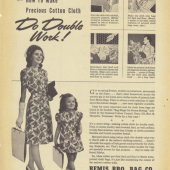
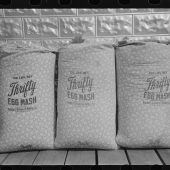

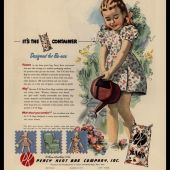
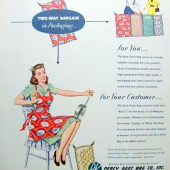
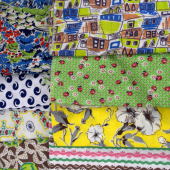
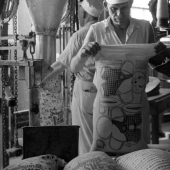
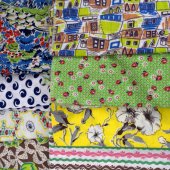
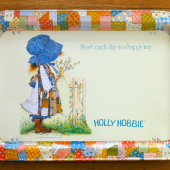
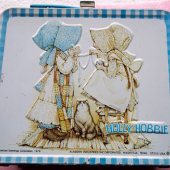
Within the next decade, feedsack fashion was a thing that wasn't just frugal necessity. Designers created new patterns, and women were competing in national competitions on who could create the best fashions from these sacks. You can see a fantastic example at the National museum of American history. Since winners would receive cash awards, this was a way for women to support their families with their skills.
By 1945, it had reached fever pitch:
“In the early 1940s, The National Cotton Council of America came out with a pattern book for sewing with feed sacks” which only enhanced the booming feed sack market. Everyone was hooked. Women were searching for the best pattern, trying to one up their prior design in hopes of receiving a compliment or winning a competition. The little rural feed sack dress had spiraled into a full blown fashion epidemic. The National Cotton Council of America made claims that their pattern book was so popular that it was “in the hands of more than one million women”
And this entire industry came from the casual observation that frugal wives would dress their children in feedsack cloth, and re-use the feedsack cloth around the house.
It is often brought up how women should be more "included" in any given industry, but even if the patent for this pattern idea may be a mans, the industry that grew from it was clearly driven by women.
In fact, by the 1970s, when nostalgia was all the rage an "old fashioned" children's toy appeared on the market, Holly Hobbie, who wore a hat and a brightly patterned patchwork dress and apron. She is practically "Sunbonnet sue flour" in a single image, and she earned her creator, Denise Holly Ulinskas, a nice living.
I wonder what casual "feed sack" observations we might have today, when the entire world has been on pause for a moment. Everyone is working from home, people are social distancing, and families are suddenly together again - at least physically. In many ways we are seeing positive things emerge from this, children getting more guidance in their schooling, families exploring their hobbies that they have space for, but also negatives. How can we as creative people expand the reach of the positive changes, how can we help change the negative? What new ideas are we seeing?
We might observe that those extremely expensive offices in cities nobody can afford to live in are of little use to anyone when nobody can use them. But how are our spending patterns changing in other ways? Is this the rebirth of the hard sell? One where the consumer now looks at their ten dollars to spend on yoghurt and thinks "that jar would also make a nice glass" again, just like we all did when we were broke college students?
I feel like there are so many opportunities here to find new ways of standing out, and making our brand the choice of today's consumer.
The pivoting of advertising ideas during the great depression are lessons we should learn from today.
